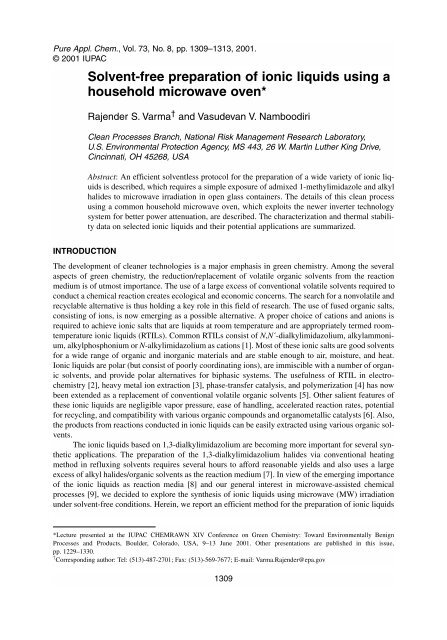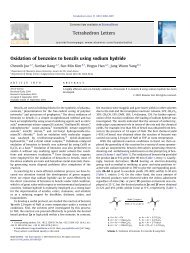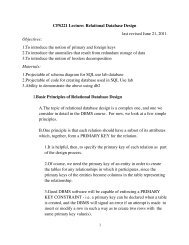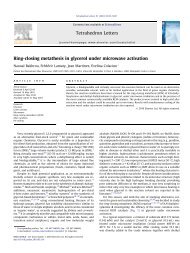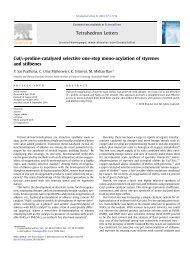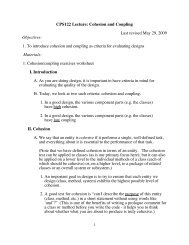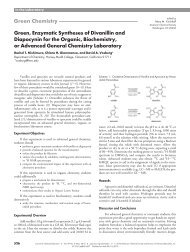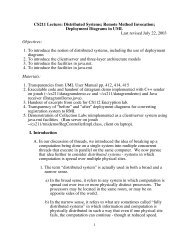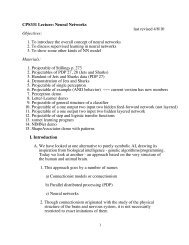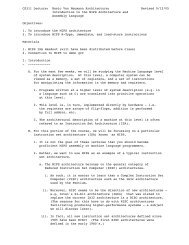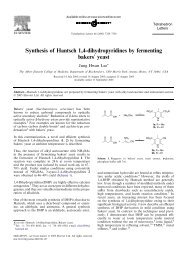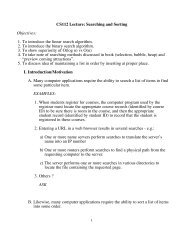Solvent-free preparation of ionic liquids using a household ...
Solvent-free preparation of ionic liquids using a household ...
Solvent-free preparation of ionic liquids using a household ...
Create successful ePaper yourself
Turn your PDF publications into a flip-book with our unique Google optimized e-Paper software.
Pure Appl. Chem., Vol. 73, No. 8, pp. 1309–1313, 2001.<br />
© 2001 IUPAC<br />
<strong>Solvent</strong>-<strong>free</strong> <strong>preparation</strong> <strong>of</strong> <strong>ionic</strong> <strong>liquids</strong> <strong>using</strong> a<br />
<strong>household</strong> microwave oven*<br />
Rajender S. Varma † and Vasudevan V. Namboodiri<br />
Clean Processes Branch, National Risk Management Research Laboratory,<br />
U.S. Environmental Protection Agency, MS 443, 26 W. Martin Luther King Drive,<br />
Cincinnati, OH 45268, USA<br />
Abstract: An efficient solventless protocol for the <strong>preparation</strong> <strong>of</strong> a wide variety <strong>of</strong> <strong>ionic</strong> <strong>liquids</strong><br />
is described, which requires a simple exposure <strong>of</strong> admixed 1-methylimidazole and alkyl<br />
halides to microwave irradiation in open glass containers. The details <strong>of</strong> this clean process<br />
<strong>using</strong> a common <strong>household</strong> microwave oven, which exploits the newer inverter technology<br />
system for better power attenuation, are described. The characterization and thermal stability<br />
data on selected <strong>ionic</strong> <strong>liquids</strong> and their potential applications are summarized.<br />
INTRODUCTION<br />
The development <strong>of</strong> cleaner technologies is a major emphasis in green chemistry. Among the several<br />
aspects <strong>of</strong> green chemistry, the reduction/replacement <strong>of</strong> volatile organic solvents from the reaction<br />
medium is <strong>of</strong> utmost importance. The use <strong>of</strong> a large excess <strong>of</strong> conventional volatile solvents required to<br />
conduct a chemical reaction creates ecological and economic concerns. The search for a nonvolatile and<br />
recyclable alternative is thus holding a key role in this field <strong>of</strong> research. The use <strong>of</strong> fused organic salts,<br />
consisting <strong>of</strong> ions, is now emerging as a possible alternative. A proper choice <strong>of</strong> cations and anions is<br />
required to achieve <strong>ionic</strong> salts that are <strong>liquids</strong> at room temperature and are appropriately termed roomtemperature<br />
<strong>ionic</strong> <strong>liquids</strong> (RTILs). Common RTILs consist <strong>of</strong> N,N´-dialkylimidazolium, alkylammonium,<br />
alkylphosphonium or N-alkylimidazolium as cations [1]. Most <strong>of</strong> these <strong>ionic</strong> salts are good solvents<br />
for a wide range <strong>of</strong> organic and inorganic materials and are stable enough to air, moisture, and heat.<br />
Ionic <strong>liquids</strong> are polar (but consist <strong>of</strong> poorly coordinating ions), are immiscible with a number <strong>of</strong> organic<br />
solvents, and provide polar alternatives for biphasic systems. The usefulness <strong>of</strong> RTIL in electrochemistry<br />
[2], heavy metal ion extraction [3], phase-transfer catalysis, and polymerization [4] has now<br />
been extended as a replacement <strong>of</strong> conventional volatile organic solvents [5]. Other salient features <strong>of</strong><br />
these <strong>ionic</strong> <strong>liquids</strong> are negligible vapor pressure, ease <strong>of</strong> handling, accelerated reaction rates, potential<br />
for recycling, and compatibility with various organic compounds and organometallic catalysts [6]. Also,<br />
the products from reactions conducted in <strong>ionic</strong> <strong>liquids</strong> can be easily extracted <strong>using</strong> various organic solvents.<br />
The <strong>ionic</strong> <strong>liquids</strong> based on 1,3-dialkylimidazolium are becoming more important for several synthetic<br />
applications. The <strong>preparation</strong> <strong>of</strong> the 1,3-dialkylimidazolium halides via conventional heating<br />
method in refluxing solvents requires several hours to afford reasonable yields and also uses a large<br />
excess <strong>of</strong> alkyl halides/organic solvents as the reaction medium [7]. In view <strong>of</strong> the emerging importance<br />
<strong>of</strong> the <strong>ionic</strong> <strong>liquids</strong> as reaction media [8] and our general interest in microwave-assisted chemical<br />
processes [9], we decided to explore the synthesis <strong>of</strong> <strong>ionic</strong> <strong>liquids</strong> <strong>using</strong> microwave (MW) irradiation<br />
under solvent-<strong>free</strong> conditions. Herein, we report an efficient method for the <strong>preparation</strong> <strong>of</strong> <strong>ionic</strong> <strong>liquids</strong><br />
*Lecture presented at the IUPAC CHEMRAWN XIV Conference on Green Chemistry: Toward Environmentally Benign<br />
Processes and Products, Boulder, Colorado, USA, 9–13 June 2001. Other presentations are published in this issue,<br />
pp. 1229–1330.<br />
† Corresponding author: Tel: (513)-487-2701; Fax: (513)-569-7677; E-mail: Varma.Rajender@epa.gov<br />
1309
1310<br />
R. S. VARMA AND V. V. NAMBOODIRI<br />
that simply involves exposing neat reactants in open glass containers to microwaves <strong>using</strong> an unmodified<br />
<strong>household</strong> MW oven. This solvent-<strong>free</strong> approach requires only a few minutes <strong>of</strong> reaction time in<br />
contrast to several hours needed under conventional heating condition, which uses an excess <strong>of</strong> reactants.<br />
A general schematic representation for the <strong>preparation</strong> <strong>of</strong> mono (1) and dicat<strong>ionic</strong> (2) 1,3-dialkylimidazolium<br />
halides is depicted below (Scheme 1).<br />
Scheme 1<br />
EXPERIMENTAL PROCEDURES<br />
The 1-methyl imidazole (MIM) and alkyl halides, obtained from Aldrich Chemical Co., are used as<br />
such. The NMR spectra <strong>of</strong> the samples are recorded on a Brucker 250 MHz spectrometer <strong>using</strong> D 2 O as<br />
solvent and CD 3 OD/CDCl 3 as the standards. The new compounds are characterized by elemental analyses,<br />
1 H and 13 C NMR. The thermogravimetric analyses (TGA) <strong>of</strong> the samples are performed by heating<br />
from 25 to 500 °C at a rate <strong>of</strong> 10 °C/min, and differential scanning calorimetry (DSC) is conducted<br />
from 25 to 450 °C at a heating rate <strong>of</strong> 10 °C/min.<br />
Preparation <strong>of</strong> <strong>ionic</strong> <strong>liquids</strong> <strong>using</strong> microwaves<br />
In a typical reaction, 1-bromobutane (2.2 mmol) and MIM (2 mmol) are placed in a test tube, mixed<br />
thoroughly on a vortex mixer (Fisher, Model 231), and the mixture is heated intermittently in an unmodified<br />
<strong>household</strong> MW oven (Panasonic NN-S740WA-1200W) at 240 W (30 s irradiation with 10 s mixing)<br />
until a clear single phase is obtained. The bulk temperature recorded is in the range 70 to 100 °C.<br />
The resulting <strong>ionic</strong> liquid is then cooled, washed with ether (3 X 2 mL) to remove unreacted starting materials,<br />
and the product is dried under vacuum at 80 °C to afford 1-butyl-3-methylimidazolium bromide<br />
(86%), 1 H NMR (250 MHz; D 2 O), δ H : 0.72 (t, CH 3 ), 1.15 (m, CH 2 ), 1.81 (m, CH 2 ), 3.71 (s, N-CH 3 ), 4.09<br />
(m, N-CH 2 ), 7.38 (s, NCH), 7.43 (s, NCH), 8.7 (s, N(H)CN); 13 C NMR δ C 12.89 (t, CH 2 ), 19.02<br />
(m, CH 3 ), 31.51 (m, CH 2 ), 35.86 (N-CH 2 ), 49.51 (N-CH 3 ), 122.40 (NCH), 123.73 (NCH), 136.21<br />
(N(H)CN). A relatively large-scale <strong>preparation</strong> (22 mmol <strong>of</strong> 1-bromobutane and 20 mmol <strong>of</strong> MIM)<br />
afforded 87 % yield.<br />
The data for a representative dicat<strong>ionic</strong> compound, entry 11, δ H (250 MHz; D 2 O) 1.29 (m, CH 2 ),<br />
1.82 (m, CH 2 ), 3.71 (s, N-CH 3 ), 4.14 (m, N-CH 2 ), 7.38 (s, NCH), 7.43 (s, NCH), 8.7 (s, NC (H)N); δ C :<br />
24.99 (t, CH 2 ), 29.17 (m, CH 3 ), 36.18 (N-CH 2 ), 49.57 (N-CH 3 ), 122.35 (NCH), 123.64 (NCH), 135.97<br />
(NC (H)N), (Calc. for C 14 H 24 N 4 I 2 : C, 33.49; H, 4.82; N, 11.16; Found. C, 33.69; H, 4.93; N, 11.68%).<br />
Suzuki cross-coupling reaction in <strong>ionic</strong> liquid<br />
The synthesis <strong>of</strong> 4-methylbiphenyl is representative: <strong>ionic</strong> liquid, butylimidazolium chloride (1 g), palladium<br />
chloride (0.050 g, 0.282 mmol), base KF (0.390 g), water (1.0 mL), 4-methylphenylboronic acid<br />
(0.150 g, 1.0 mmol) and bromobenzene (0.156 g, 1 mmol) are placed in a 25-ml round-bottomed flask<br />
© 2001 IUPAC, Pure and Applied Chemistry 73, 1309–1313
<strong>Solvent</strong>-<strong>free</strong> <strong>preparation</strong> <strong>of</strong> <strong>ionic</strong> <strong>liquids</strong> 1311<br />
and mixed well. The flask is then heated in a MW oven at 240 W for (30 + 10 + 10 + 10) seconds. The<br />
product was extracted with ether and was purified by flash chromatography to yield 4-methyl biphenyl<br />
(80%); mp 44.0–45.0 °C; 1 H NMR (CDCl 3 ; δ) 7.40 (m, 9H), 2.37 (s, 3H). The <strong>ionic</strong> liquid containing<br />
palladium catalyst and base are then recycled.<br />
Table 1 Preparation <strong>of</strong> alkyl imidazolium halides <strong>using</strong> a <strong>household</strong> microwave oven.<br />
Entry Alkyl halide (RX) RX MIM MW-(240 W) Yield % Yield a %<br />
mmol mmol (time: s) (time: h)<br />
1 1-bromobutane 2.2 2 (30 + 15 + 15 + 15) 86 76 (5)<br />
2 1-chlorohexane 2.2 2 (30 + 15 + 15 + 15 + 15) 81 53 (5)<br />
3 1-bromohexane 2.2 2 (30 + 15 + 15 + 15) 89 78 (5)<br />
4 1-iodohexane 2.2 2 (30 + 10 + 10 + 10) 93 89 (3)<br />
5 1-iodoheptane 2.2 2 (30 + 10 + 10 + 10) 94 95 (3)<br />
6 1-bromooctane 2.2 2 (30 + 15 + 15 + 15) 91 73 (5)<br />
7 1,4-dibromobutane 1 2.2 (30 + 15 + 15 + 15) 81 76 (5)<br />
8 1,4-diiodobutane 1 2.2 (15 + 15 + 10 + 10) 91 89 (3)<br />
9 1,6-dichlorohexane 1 2.2 (30 + 15 + 15 + 15 + 15) 82 56 (5)<br />
10 1,6-dibromohexane 1 2.2 (30 + 15 + 10 + 10) 92 72 (5)<br />
11 1,6-diiodohexane 1 2.2 (15 + 15 + 10 + 10) 85 97 (3)<br />
12 1,8-dichlorooctane 1 2.2 (30 + 15 + 15 + 15 + 15) 78 72 (5)<br />
13 1,8-dibromooctane 1 2.2 (30 + 15 + 15 + 15) 92 76 (5)<br />
14 1,8-diiodooctane 1 2.2 (15 + 15 + 10 + 10) 94 93 (3)<br />
a Alternative heating method (oil bath at 80 °C).<br />
RESULTS AND DISCUSSIONS<br />
In an unmodified <strong>household</strong> MW oven it is not possible to effectively adjust the MW power. The reduction<br />
in power level simply entails that it operates at its full power but for a reduced period <strong>of</strong> time. A<br />
recently introduced <strong>household</strong> MW oven (Panasonic) equipped with inverter technology provides a<br />
realistic control <strong>of</strong> the microwave power to a desirable level. We examined the effect <strong>of</strong> microwave<br />
power on a set <strong>of</strong> reactions <strong>using</strong> alkyl halides and MIM as reactants and found that operating the MW<br />
oven at reduced power level <strong>of</strong> 240 W afforded the highest yields. Upon microwave irradiation, the <strong>ionic</strong><br />
liquid starts forming, which increases the polarity <strong>of</strong> the reaction medium thereby increasing the rate <strong>of</strong><br />
microwave absorption. It is observed that at elevated power levels evaporation <strong>of</strong> alkyl halide and partial<br />
decomposition/charring <strong>of</strong> the <strong>ionic</strong> liquid occurs possibly owing to the localized overheating <strong>of</strong><br />
<strong>ionic</strong> liquid, which eventually results in lower yields. To circumvent this problem, the reactions are conducted<br />
with intermittent heating and mixing at a moderate power level to obtain better yields and cleaner<br />
<strong>ionic</strong> liquid formation. After the first irradiation for 30 s at 240 W (~bulk temperature 70–100 °C)<br />
the homogeneity <strong>of</strong> the reaction mixture changes due to formation <strong>of</strong> a small amount <strong>of</strong> <strong>ionic</strong> liquid.<br />
The reaction mixture is then taken out, mixed again for 10 s, and then heated at same power level for<br />
additional 15 s. This process is repeated until the formation <strong>of</strong> a clear single phase is obtained. Thus,<br />
the formation <strong>of</strong> <strong>ionic</strong> liquid could be monitored visibly in the reaction as it turns from clear solution<br />
to opaque and finally clear. Any unreacted starting materials are removed by washing with ether, and<br />
the product is dried under vacuum at 80 °C.<br />
This method is ideally suited for the <strong>preparation</strong> <strong>of</strong> <strong>ionic</strong> <strong>liquids</strong> with longer alkyl chains or with<br />
higher boiling points. Comparison <strong>of</strong> a series <strong>of</strong> <strong>ionic</strong> <strong>liquids</strong> prepared by MW heating and similar<br />
<strong>preparation</strong> <strong>using</strong> conventional heating (oil bath at 80 °C) is summarized in Table 1. Most <strong>of</strong> the halides<br />
used in this study have higher boiling points and are converted efficiently to <strong>ionic</strong> <strong>liquids</strong> under MW<br />
irradiation. The relatively less reactive and low boiling reactants such as 1-bromobutane incurred loss<br />
due to evaporation and require excess quantity for best results. The reactivity trend <strong>of</strong> halides is found<br />
© 2001 IUPAC, Pure and Applied Chemistry 73, 1309–1313
1312<br />
R. S. VARMA AND V. V. NAMBOODIRI<br />
to be in the order I – > Br – > Cl – . Highly reactive iodides afforded excellent yield <strong>of</strong> <strong>ionic</strong> <strong>liquids</strong> in all<br />
cases with minimum exposure time. In contrast, the conventional methods reported in the literature generally<br />
use a large excess <strong>of</strong> alkyl halide or tetrahydr<strong>of</strong>uran as solvents.<br />
In view <strong>of</strong> the emerging interest in <strong>ionic</strong> <strong>liquids</strong> bearing polycations, we have prepared novel dicat<strong>ionic</strong><br />
compounds (2) utilizing alkyl dihalides. The butyl and hexyl dicat<strong>ionic</strong> salts (entries 7–11, Table 1)<br />
are solids at room temperature. The corresponding octyl analogs with bromide/chloride as the anions<br />
are viscous <strong>liquids</strong> (entries 12 and 13, Table 1), whereas the iodo compound (entry 14, Table 1) is a<br />
solid. The NMR data shows that the dicat<strong>ionic</strong> salts generated from chloro and bromoalkanes (entries<br />
7, 9, 10, 12, and 13, Table 1) are slightly contaminated with the corresponding monocat<strong>ionic</strong> intermediate<br />
(
<strong>Solvent</strong>-<strong>free</strong> <strong>preparation</strong> <strong>of</strong> <strong>ionic</strong> <strong>liquids</strong> 1313<br />
4. A. J. Carmichael, D. M. Haddleton, S. A. F. Bon, K. R. Seddon. Chem. Commun. 1237 (2000).<br />
5. J. S.Wilkes, M. J. Zaworotko. J. Chem. Soc. Chem. Commun. 965 (1992).<br />
6. J. D. Holbrey and K. R. Seddon. Clean Products Processes 1, 223 (1999); J. G. Huddleston,<br />
H. D. Willauer, R. P. Swatloski, A. E. Visser, R. D. Rogers. Chem. Commun. 1765 (1998).<br />
7. P. Volker, W. Bohm, W. A. Herrmann. Chem. Eur. J. 6, 1017 (2000).<br />
8. For the recent commentary on the general utility <strong>of</strong> <strong>ionic</strong> <strong>liquids</strong> see: M. Freemantle. Chem. Eng.<br />
News, 1 January, p. 21 (2001); M. Freemantle. Chem. Eng. News, 15 May, p. 37 (2000).<br />
9. R. S. Varma. In Green Chemistry: Challenging Perspectives, P. Tundo, P. T. Anastas (Eds.), pp.<br />
221, Oxford University Press, Oxford (2000); R. S. Varma. J. Heterocyclic Chem. 35, 1565<br />
(1999); R. S. Varma. Green Chemistry 1, 43 (1999); R. S. Varma. Clean Products Processes 1,<br />
132 (1999); R. S. Varma. Pure Appl. Chem. 73, 193 (2001).<br />
10. V. V. Namboodiri and R. S. Varma. Green Chemistry 3, 146 (2001).<br />
© 2001 IUPAC, Pure and Applied Chemistry 73, 1309–1313


